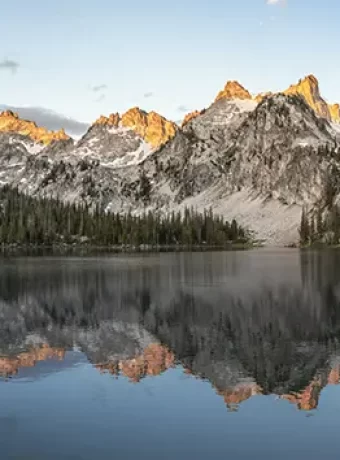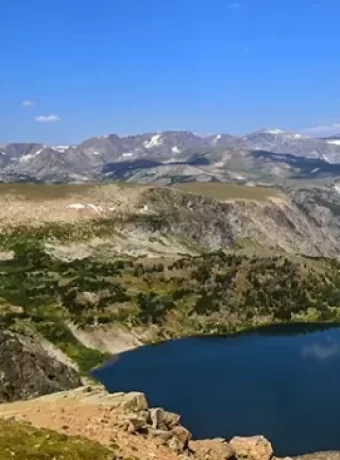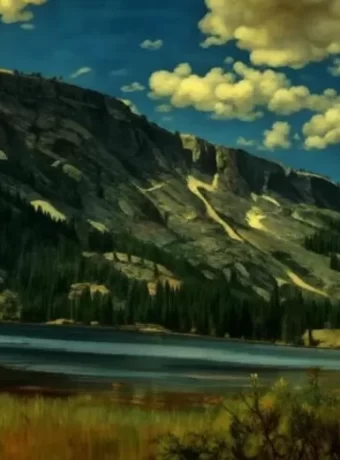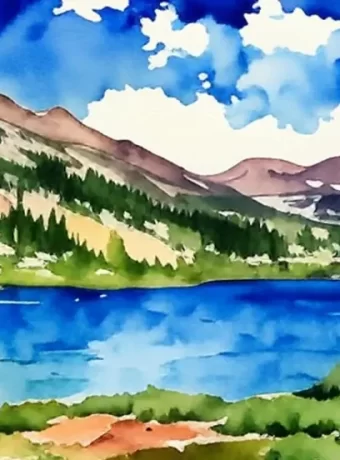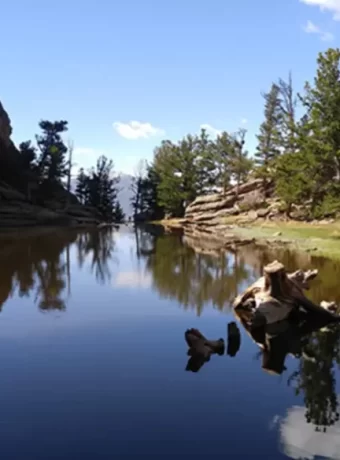Exploring Alaska Ghost Towns, with its vast and rugged landscape, hides stories in every nook and cranny. Among these are tales of towns that thrived but now stand still in time. **Alaska ghost towns 13 best** dives deep into the heart of Alaska’s forgotten settlements. You’ll learn about Kennicott, where copper was king until silence took over, and Portage, a town shattered by nature’s fury. We explore Sulzer’s dual life as a mining hub and fishing village before it faded away.
This journey isn’t just about ruins; it’s an exploration of history, resilience, and the passage of time itself. From the gold rush remnants at Treadwell Ruins to Fort Egbert’s military past—each site tells a unique story. Ready for an adventure? Let’s dive into the secrets hidden behind these forgotten thresholds.
Exploring Alaska Ghost Towns, connect with Alaska’s wildlife on a fly fishing excursion.
Table Of Contents:
- The Enigmatic World of Alaska’s Ghost Towns
- The Tragic Tale of Portage Ghost Town
- Sulzer – From Prosperity to Silence
- Ukivok – A Hillside Mystery Abandoned for Decades
- Treadwell Ruins – Echoes of Gold Rush Prosperity
- The Forgotten Stages of Dyea
- The Lost Colony of Three Saints Bay
- The Military Legacy at Fort Egbert
- Mysteries Beyond Mainstream – Lesser-Known Haunts
- FAQs in Relation to Alaska Ghost Towns 13 Best
- Conclusion of Alaska Ghost Towns
- Journey From Alaska into Canada or Fly Fish Iceland
The Enigmatic World of Alaska’s Ghost Towns
Alaska, a land of stark beauty and harsh conditions, is home to some of the most intriguing ghost towns in America. Abandoned enclaves echo stories of flourishing epochs that crumbled, providing a distinct window into Alaska’s opulent past.
Kennicott Ghost Town – A Copper Giant’s Fall
Among these spectral cities stands Kennicott, once the heartbeat of Alaska’s copper mining industry. At its zenith, this town was not just any mining camp but the world’s richest source of copper. Today, it serves as a frozen snapshot in time with over $200 million worth extracted from its depths before abandonment. For those looking to explore this piece of Alaskan heritage firsthand, more information on visiting Kennicott can be found here.
Visitors today are greeted by well-preserved buildings set against breathtaking natural scenery—a testament to man’s fleeting dominance over nature.

While exploring Alaska’s back country and History wear a hydrophobic graphic hoodie with a upf-50 sun protection as an outer layer.
The Tragic Tale of Portage Ghost Town
In contrast lies Portage, a town that met its demise under far different circumstances than economic downturns or depleted resources. Struck by the second largest earthquake ever recorded in 1964, this area now exists as eerie ruins amidst stunning landscapes.

Out learning of Alaska’s Mysteries, prosperity and tales of woo. A Grizzly Bear Graphic Hoodie with a sewn in face mask UPF-50. Wicking and great bear camo as a outer layer on warmer days and base layer on cooler days.
The quake reshaped not only physical terrain but also human lives and communities; what remains is a haunting reminder that our grip on earth is tenuous at best.
Sulzer – From Prosperity to Silence
Then there’s Sulzer on Prince Of Wales Island—an emblematic site where copper mining meshed with seasonal fishing camps, demonstrating Alaska’s reliance on both terrestrial and marine bounty.
This blend wasn’t enough to keep Sulzer alive indefinitely though; like many others, it eventually succumbed to silent abandonment despite being a central hub for such activities.
Treadwell Ruins – Echoes Of Gold Rush Prosperity
Moving towards Douglas Island brings us Treadwell, which harbors remnants of Alaska’s first indoor swimming pool. Once a thriving gold mine community, it has left behind foundations of its past grandeur; one can still trace outlines of immense wealth and opportunities presented during the height of the Klondike rush through decaying structures dotted across the landscape.
Ukivok Hillside Mystery Abandoned Decades
Balancing on steep slopes, Ukivok narrates a tale of enduring through sheer remoteness and tough habitats. Yet even the hardiest souls couldn’t fend off eventual desertion. Despite this, its legacy continues to inspire those who hear its tale, a testament to human endurance against all odds.
Alaska’s ghost towns, like Kennicott and Portage, tell stories of nature’s power and human ambition. From copper riches to earthquake ruins, they offer a unique peek into history amid stunning landscapes.
The Tragic Tale of Portage Ghost Town
Portage Ghost Town, now a silent witness to nature’s mighty and capricious force, narrates a chilling saga through its eerie quietude. This small town, once bustling with life, met an untimely demise in 1964 when it was devastated by the second largest earthquake in recorded history. The remnants of devastation whisper a somber lesson in humility, illustrating just how vulnerably our lives dangle on the caprices of this planet.
The catastrophe not only remolded the terrain but also irrevocably shifted life’s trajectory for Portage’s residents, setting them on a path they never anticipated. Buildings that had stood as markers of human settlement were reduced to rubble within minutes. Today, what remains are echoes of memories and lives interrupted abruptly by natural forces beyond control.
Sulzer – From Prosperity to Silence
Sulzer on Prince Wales Island narrates another facet of Alaskan abandonment stories where prosperity once echoed between mountainsides rich with copper ore deposits intertwined alongside vibrant fishing activities. Sulzer was known for being both a pivotal hub for copper mining along hosting lively seasonal fishing camps which now lay silent under layers of accumulated histories whispers from days gone by. The blissful activity slowly drowned out by ever-changing tides of time, leaving us to ponder what might have been if fortunes hadn’t turned away from these shores. If curious about intertwining destinies of industries and communities like Sulzer, delving further into investigations could unveil intriguing tales waiting beneath the surface, asking to be discovered anew by aspiring historians and adventurers alike seeking to understand the complexities involved in the rise and fall of such unique places.
Portage’s silence teaches us about nature’s raw power and unpredictability, while Kennicott showcases the remnants of human ambition against economic changes. Sulzer tells a quieter story of prosperity lost to time. Each town offers a unique lens into Alaska’s past, inviting exploration and reflection on the forces shaping our world.
Sulzer – From Prosperity to Silence
Imagine a place where the echoes of prosperity have faded into whispers. Sulzer, located on Prince of Wales Island, was once bustling with life, driven by copper mining and fishing activities. Today, it stands in stark contrast as an abandoned town, silently holding stories of its past.
The Dual Life of Sulzer
Once the jewel of its region, Sulzer flourished as a vital nexus for the extraction of copper and harvesting of marine life, embodying more than just an ordinary town. Sulzer’s identity, woven from the riches underground and the ocean’s abundance, nurtured a community flourishing in an era where copper and fish were kings. Sulzer’s twofold essence propelled its prosperity yet eventually laid the groundwork for its abandonment as resources diminished.
The decline began subtly at first—a mine closure here, a reduction in fish stocks there—until all that remained were empty buildings echoing with memories. It’s fascinating how nature reclaims spaces once dominated by human activity; today’s visitors are greeted by scenes more reminiscent of movie sets than former places of industry.
A Glimpse into History
Understanding Sulzer requires delving into Alaska’s broader narrative around exploitation and abandonment during resource rushes. Kennicott Ghost Town, another symbol within this narrative shares similar tales: immense wealth extraction followed by rapid departure upon depletion. These ghost towns dotting Alaska map out paths where fortune seekers once treaded seeking gold or copper riches.
With over $200 million worth extracted from Kennicott alone before abandonment settled in tells you about scale these operations reached at their peak—the same kind scales witnessed back then played out smaller yet significant ways across other parts like Sulzer too forming crucial chapters state’s history book marked ‘boom bust’ cycles so common resource-dependent regions worldwide. What makes particularly interesting is how well preserved many such sites remain offering windows time allowing us step back imagine what might have been had fortunes turned differently perhaps leading different outcome altogether one doesn’t leave behind only silence testimony endeavors pursued therein.
Nature Takes Back Its Realm
Today’s visit to Sulzer is less about witnessing active community life more exploring artifacts left behind those who called home years ago among rusting machinery wooden structures slowly being consumed forest surrounding them signifying unstoppable force nature reclaiming every inch given enough however brief interlude man-made intervention may seem comparison eternal timelines governed natural world itself serves reminder our temporary presence earth scope things larger perspective offers comfort knowing continues thrive even after we’re gone albeit slightly altered form thanks endeavors embarked upon periods habitation whether prosperous silent remains seen those choose explore forgotten corners like themselves looking understand piece puzzle making up complex tapestry known Alaskan wilderness.
Discover Sulzer, where the buzz of prosperity has given way to silence. Once a thriving hub for copper mining and fishing, it now stands as a ghost town on Prince of Wales Island, holding tales of boom and bust. Explore this relic of Alaska’s rich yet fleeting industrial past.
Ukivok – A Hillside Mystery Abandoned for Decades
If you’ve ever wondered about the eerie beauty that lies in abandonment, Ukivok on King Island is a masterclass. For more than half a century, this deserted town on the slope has not only presented breathtaking panoramas but also invites us to explore the narratives of its former inhabitants. Imagine homes perched precariously on stilts against steep slopes—a sight both beautiful and haunting.
Ukivok’s tale weaves a narrative of enduring the harshness only to face an inevitable exodus. Originally a seasonal fishing camp utilized by indigenous people, it became their permanent village due to its strategic location for hunting marine mammals. However, as modernization crept in and traditional ways waned under external pressures including mandatory schooling away from home—the heartbeats of this community began to fade until they stopped altogether.
Today, what remains are structures defying gravity and time—abandoned yet stoic against harsh weather conditions; they whisper tales of resilience amidst change. Despite being uninhabited since the 1970s when residents left seeking better opportunities elsewhere or forced out by governmental policies regarding education among indigenous populations; Ukivok continues to captivate with its mystery and melancholy charm.

Out exploring Alaska mysteries the sun can be intense. Gloves are a great idea at a UPF-50 sun protection. These are great for driving, hiking and fly fishing apparel. Work great as photography glove. Graphic Outdoor Apparel
Exploring What’s Left Behind
The silence in Ukivok speaks volumes about Alaska’s history during times when communities thrived off the land and sea before abruptly transitioning into ghost towns like many others across this vast state. It stands as a poignant symbol, illustrating that locations transcend mere geographical points—they embody narratives crafted by the lives and stories of people.
Venturing into this abandoned town requires careful planning because getting there isn’t straightforward—it involves either boat trips or challenging hikes depending upon weather conditions which can be unpredictable at best. But those who make it are rewarded with not only breathtaking sceneries but also lessons in impermanence taught by dilapidated buildings standing guard over memories long past.
A visit here truly highlights how nature slowly reclaims spaces humans leave behind: floors swallowed up by vegetation; walls crumbling under weight unseen forces while window frames gaze outward toward horizons unbounded—each element telling stories without words needed because sometimes silence communicates more profoundly than any spoken language could hope too.
Ukivok, a ghost town on King Island, tells a haunting tale of beauty in abandonment and resilience amid change. Its homes on stilts and deserted structures offer lessons in history’s impermanence and nature’s reclaiming power—making it an unforgettable journey into Alaska’s past.
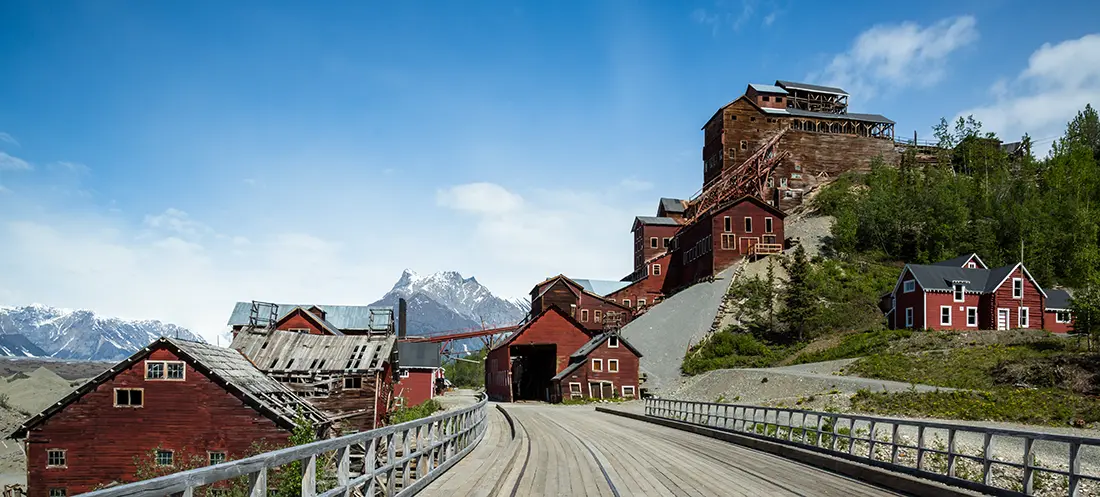
Treadwell Ruins – Echoes of Gold Rush Prosperity
Step back in time at the Treadwell Ruins on Douglas Island, where echoes of Alaska’s gold rush prosperity still linger. Once thrumming with activity, this locale boasted the first enclosed aquatics center in Alaska at its zenith as a hub for mineral extraction. Now, it beckons explorers to wander its relics and envision the bustling days of gold rush fervor.
Kennicott Ghost Town – A Copper Giant’s Fall
Alaska is home to over 100 abandoned settlements, but none quite capture the imagination like Kennicott Ghost Town. Once celebrated as the world’s richest copper mine, Kennicott extracted more than $200 million worth of copper before being abandoned. Now preserved within Wrangell-St Elias National Park, this ghost town offers well-preserved buildings against a breathtaking natural backdrop. For those intrigued by Alaska’s rich mining history or stunning landscapes, Kennicott Ghost Town Information provides an essential guide for planning your visit.
The decline from prosperity to silence is not unique to Kennicott; many Alaskan towns share similar fates due to various disasters or economic downturns. The stories behind these ghost towns offer insight into both human resilience and nature’s unpredictability.
The Tragic Tale of Portage Ghost Town
In contrast stands Portage Ghost Town – forever marked by tragedy when it was devastated by one of history’s second largest earthquakes in 1964. Now, these remnants stand as eerie monuments to the formidable power of nature and the swift shift from prosperity to desolation. Portage isn’t just another name on a list; it symbolizes how entire communities can be wiped off maps overnight, yet their stories endure through sites like these—drawing curious minds keen on unraveling tales locked within broken walls and silent streets.
Sulzer – From Prosperity to Silence
Nestled on Prince of Wales Island lies Sulzer—a former hub for both fishing activities and copper mining operations whose abandonment tells yet another tale of fluctuating fortunes tied closely with natural resources exploitation. Sulzer serves as evidence that wealth drawn from earth or sea guarantees no permanence unless balanced wisely with sustainability considerations; thus reminding us all about broader environmental stewardship lessons hidden amidst these historical narratives.
Discover Alaska’s ghost towns, where history whispers from abandoned ruins. From Treadwell’s gold rush echoes to Kennicott’s copper wealth and Portage’s tragic quake aftermath, each site tells a unique story of prosperity, loss, and nature’s power. These places are not just relics but lessons in resilience and environmental stewardship.
The Forgotten Stages of Dyea
Imagine stepping back into a time when the air buzzed with excitement and the promise of gold. This was Dyea, once a bustling staging spot for thousands during the Klondike Gold Rush. Now, it softly murmurs its history, beckoning us to uncover the secrets now enfolded by the wild.
Kennicott Ghost Town – A Copper Giant’s Fall
In contrast to Dyea’s story of gold rush fever, Kennicott tells a tale of copper riches. It stands in silence among Alaska’s abandoned settlements but offers visitors a vivid glimpse into an era where it boasted as the world’s richest copper mine. Over $200 million worth of copper was extracted here before abandonment. For more on this captivating site within Wrangell-St Elias National Park, consider exploring Kennicott Ghost Town Information.
The preservation efforts have allowed Kennicott to remain one of Alaska’s most visually arresting ghost towns; its buildings against a backdrop that could easily be mistaken for paintings.
The Tragic Tale of Portage Ghost Town
Moving towards tragedy brought by natural calamities rather than economic downturns or resource depletion—Portage provides such narrative after being devastated by 1964 earthquake—the second largest recorded quake globally leaving behind ruins as haunting reminders.
This small town now serves as an eerie memorial to nature’s unpredictable might and resilience needed in facing her wrath—a somber reflection contrasting sharply with stories like those found at Pilgrim Hot Springs or Buckner Building which narrate slow reclamation by nature or military history respectively.
Sulzer – From Prosperity to Silence
Another compelling story comes from Sulzer located on Prince Wales Island. Once thriving due both to fishing activities and copper mining operations it eventually succumbed not just economically but also physically disappearing almost entirely under dense Alaskan forest cover further emphasizing how man-made endeavors often are temporary compared earth’s persistent reclaiming force.
Treadwell Ruins – Echoes Of Gold Rush Prosperity
Douglas Island is home Treadwell Ruins showcasing remnants not only industrial achievements like first indoor swimming pool Alaska ever had during peak times mining town but also personal dreams ambitions many who came seeking fortune were made manifest through their hard work despite eventual downfall operation due accidents flooding leading total evacuation hence becoming yet another name list captivating though melancholic histories scattered across state landscape today reminding us impermanence even grandest human constructions amidst relentless march time itself.
Dive into Alaska’s past with ghost towns like Dyea and Kennicott, where nature reclaims history. From gold rush dreams in Treadwell to copper fortunes in Kennicott, each town tells a unique story of prosperity turned to ruins. Explore these silent witnesses to time’s relentless march.
The Lost Colony of Three Saints Bay
Nestled in Alaska’s annals, Three Saints Bay stands as the cradle of America’s inaugural Russian settlement. This small settlement, now an echo among ghost towns, marks where Russia began its ambitious venture into Alaskan territories. The bay itself is named after one of the ships that brought settlers to this remote outpost.
Diving Into History
In 1784, under the guidance of Grigory Shelikhov, Russians planted their roots on Kodiak Island, establishing what would become known as Three Saints Bay. In a bold move that echoed through time, this endeavor was Russia’s audacious stride to stretch its dominion and sway far into the Pacific’s embrace. For those who relish uncovering forgotten chapters of American history, learning about this first Russian colony provides intriguing insights into early interactions between Europeans and native Alaskans.
Despite its initial promise and strategic position for trade and expansion, life at Three Saints Bay was far from easy. Colonists faced a relentless struggle for existence, grappling with severe climatic adversities, complicated provisioning from their distant Russian homeland, and strained relations with the local populations.
A Glimpse Into Everyday Life
In Three Saints Bay, settlers navigated a landscape rich with opportunities yet fraught with hurdles, embodying the true essence of pioneering. They engaged primarily in fur trading—specifically sea otter pelts—which were highly valued back in Europe due to their warmth and luxurious texture. But beyond economic pursuits lay a complex tapestry of cultural exchanges with Native populations like the Aleut people—who played critical roles as guides, interpreters, and skilled hunters essential for the survival strategy of these early settlers.
Today, National Historic Landmark designations help preserve such sites’ legacies by acknowledging their significance within broader narratives of American development. Exploring these remnants offers us tangible links to past lives—and forces us to consider how various cultures have navigated encounters at crossroads like Three Saints Bay. With every visit or study, we don’t just remember; we also honor diverse histories woven together through perseverance, pioneering spirit, and mutual respect. Finding beauty in ruins allows us to grasp intricate historic human connections carved out amidst Alaska’s vast wilderness.
For anyone fascinated by stories of exploration, resilience, and adaptation—Three Saints Bay invites you deeper into understanding.
Dive into America’s first Russian colony at Three Saints Bay, where tough pioneers traded fur and navigated cultural exchanges with Native populations. Today, exploring its ruins offers a unique glimpse into early American history and the enduring spirit of exploration.
The Military Legacy at Fort Egbert
Constructed amidst Alaska’s gold frenzy, Fort Egbert offers a captivating glimpse into history, capturing the intertwined destinies of troops and adventurers at this secluded bastion. Today, it stands as a testament to the enduring spirit of those who ventured into the unknown for glory and gold.
Pilgrim Hot Springs – Nature Reclaims Its Ground
Nestled on the Seward Peninsula lies Pilgrim Hot Springs, a ghost town slowly being reclaimed by nature. Once bustling with activity, its sinking structures are now silent witnesses to time’s passage. This area is not just about decay; it’s also home to hot springs that continue to bubble up warmth from deep within Earth’s crust—a natural wonder that captivates visitors.
A visit here isn’t merely an exploration of abandoned buildings but an encounter with geothermal energy in its raw form. For more insights on this captivating site, consider exploring Pilgrim Hot Springs on Seward Peninsula.
Buckner Building’s Cold War Relics
In Whittier stands the Buckner Building—a colossal structure echoing tales from its Cold War prime when it functioned as a self-contained city. Despite its deserted halls today, one can almost hear whispers of military strategies discussed behind closed doors or envision soldiers walking through corridors filled with purpose.
This behemoth serves as both relic and reminder of geopolitical tensions once felt worldwide—its massive rooms designed for efficiency now stand empty yet full of stories waiting to be told by those willing to listen closely enough.
Spirits at Jesse Lee Home
The Jesse Lee Home merges architectural beauty with eerie silence following abandonment post-natural disaster—rumors suggest spirits roam these grounds due partially restored buildings still standing tall against Alaskan elements but haunted by memories long past. Reports vary from fleeting shadows caught out corner eyes soft footsteps heard traversing otherwise quiet floors—whether fact fiction, there no denying air mystery surrounding what was once vibrant center community life.
- Ft Egbert offers unique insights into how two distinct groups—the military personnel stationed there and fortune-seeking individuals looking for their big break during Alaska’s famed Gold Rush coexisted amidst harsh conditions far removed from familiar comforts found elsewhere in America during that period. It symbolizes resilience adaptation necessary survive thrive such extreme environment.
- Pilgrim Hot Spring reminds us even man-made establishments eventually succumb forces nature given enough time leaving behind remnants civilization slow process reclamation ground which they were built upon takes place unending cycle creation destruction perpetuates itself indefinitely.
Fort Egbert shines a light on the gold rush’s dual legacy, where soldiers and seekers shared dreams in the wild. Pilgrim Hot Springs reveals nature’s reclaiming power, offering both history and natural hot springs for exploration. The Buckner Building whispers Cold War secrets, standing as a giant relic of past tensions. Lastly, Jesse Lee Home combines beauty with mystery, rumored to be walked by spirits of its storied past.
Mysteries Beyond Mainstream – Lesser-Known Haunts
Alaska, brimming with historical depth and enigmatic allure, cradles ghost towns that murmur secrets from yesteryears. Venturing into these deserted towns provides an off-the-beaten-path experience, where every nook and cranny holds a narrative eager to unfold.
Dyea: The Forgotten Gateway
In the shadows of Skagway lies Dyea, once a bustling staging spot for gold miners eager to trek the Chilkoot Trail during the Klondike Gold Rush. Today, it’s reclaimed by nature but remains rich in stories and adventure. Here at Dyea’s historical site, visitors can wander through silent forests where dreams of fortune once flourished.
The transformation from a pivotal point during the Klondike Gold Rush to an almost erased footprint on Earth intrigues many who visit this place. Nature has overtaken structures and streets where thousands once passed through, aiming for gold-laden lands.
Three Saints Bay: Echoes of Russia’s Past
Kodiak Island harbors secrets from America’s first Russian colony at Three Saints Bay. This settlement marks when Russia planted its roots deep into Alaskan soil—a significant chapter in Alaska’s history now buried under layers of time and tide.
Visitors intrigued by these echoes can delve deeper into Kodiak Island’s Russian heritage, a journey back into a seldom-discussed era before Alaska became part of America.
Portlock: A Mystery Shrouded In Legends
Nestled within Kenai Peninsula’s rugged landscape was Portlock—now only remembered through legends speaking about mysterious disappearances leading residents left behind their homes perched against stunning vistas over Cook Inlet. Though physical remnants are scarce, this town started as a seasonal fishing camp before evolving into a small ghost town haunted not just by spirits but also intriguing unsolved mysteries.
- Spend time exploring what remains and imagining life as it used to be
- Talk to locals or historians to gain insights into hidden stories
- Respect the sacredness of these places, remembering they were someone else’s home and dream
These destinations remind us how quickly nature reclaims man-made creations and how easily entire communities can fade from memory if not preserved or remembered. This venture beyond well-trodden paths reveals depth and richness far removed from the hustle and bustle of modern-day tourist spots, offering a genuine glimpse into worlds that once were. Venturing into these abandoned locales allows us to intertwine with history in a singular manner, deepening our grasp of bygone eras and admiring nature’s unstoppable force.
Dive into Alaska’s ghost towns to uncover history beyond the usual. From Dyea’s gold rush echoes to Kodiak Island’s Russian past, and Portlock’s legends, these spots offer a peek into forgotten tales. Engage with locals for deeper stories and respect these sacred remnants of dreams.
FAQs in Relation to Alaska Ghost Towns 13 Best
What happened to the people in Portlock Alaska?
Folks left Portlock due to mysterious events and fear, turning it into a ghost town by 1950.
What is the most famous Alaska ghost town?
Kennicott takes top honors as Alaska’s most renowned ghost town, famed for its mining history and preservation.
Does anybody live in Portlock Alaska?
Nope. These days, no one calls Portlock home; it’s all ruins and stories now.
How many abandoned towns are in Alaska?
Around 100 settlements across Alaska got ditched over time for various reasons like natural disasters or industry declines.
Conclusion of Alaska Ghost Towns
Exploring Alaska ghost towns 13 best has taken us on a journey through time. We’ve seen the rise and fall of Kennicott, felt the tremors that silenced Portage, and walked the deserted streets of Sulzer.
From these tales, remember: history is alive in ruins. Every location murmurs tales of ambition, calamities, and resilience.
Dive deep into nature’s reclaim at Pilgrim Hot Springs or stand in awe at Treadwell Ruins—every location offers a unique slice of Alaskan heritage.
Embark on this journey, letting curiosity guide you to uncover hidden gems. Alaska’s past beckons with lessons for today; its abandoned corners are rich with stories waiting to be told.
So grab your map and set out. The ghost towns won’t discover themselves! Or maybe they have.
Journey From Alaska into Canada or Fly Fish Iceland
A short hop down to Fortress Lake in Canada. Catch a plane to Fly Fish Iceland for the experience of a Lifetime. Or something in the dry fly challenge arena a Montana Spring Creek. Places to explore are endless. Do a Yellowstone Cabin Rental and fly fish the rest of your life every day and never cast to the same stretch of water.


